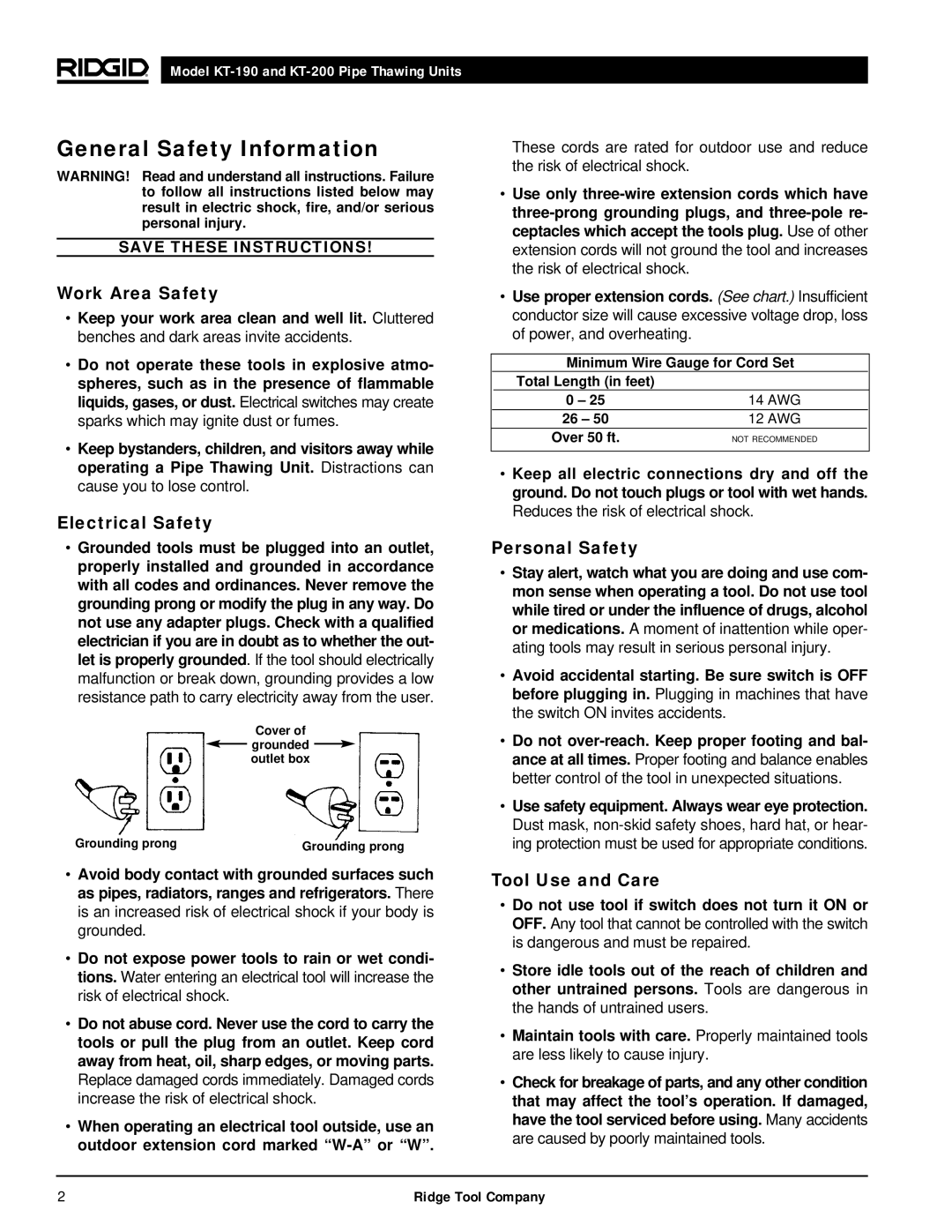
Model
General Safety Information
WARNING! Read and understand all instructions. Failure to follow all instructions listed below may result in electric shock, fire, and/or serious personal injury.
SAVE THESE INSTRUCTIONS!
Work Area Safety
•Keep your work area clean and well lit. Cluttered benches and dark areas invite accidents.
•Do not operate these tools in explosive atmo- spheres, such as in the presence of flammable liquids, gases, or dust. Electrical switches may create sparks which may ignite dust or fumes.
•Keep bystanders, children, and visitors away while operating a Pipe Thawing Unit. Distractions can cause you to lose control.
Electrical Safety
•Grounded tools must be plugged into an outlet, properly installed and grounded in accordance with all codes and ordinances. Never remove the grounding prong or modify the plug in any way. Do not use any adapter plugs. Check with a qualified electrician if you are in doubt as to whether the out- let is properly grounded. If the tool should electrically malfunction or break down, grounding provides a low resistance path to carry electricity away from the user.
Cover of
![]() grounded
grounded ![]() outlet box
outlet box
Grounding prong |
|
Grounding prong |
•Avoid body contact with grounded surfaces such as pipes, radiators, ranges and refrigerators. There is an increased risk of electrical shock if your body is grounded.
•Do not expose power tools to rain or wet condi- tions. Water entering an electrical tool will increase the risk of electrical shock.
•Do not abuse cord. Never use the cord to carry the tools or pull the plug from an outlet. Keep cord away from heat, oil, sharp edges, or moving parts. Replace damaged cords immediately. Damaged cords increase the risk of electrical shock.
•When operating an electrical tool outside, use an outdoor extension cord marked
These cords are rated for outdoor use and reduce the risk of electrical shock.
•Use only
•Use proper extension cords. (See chart.) Insufficient conductor size will cause excessive voltage drop, loss of power, and overheating.
Minimum Wire Gauge for Cord Set
Total Length (in feet)
0 – 25 | 14 AWG |
26 – 50 | 12 AWG |
Over 50 ft. | NOT RECOMMENDED |
•Keep all electric connections dry and off the ground. Do not touch plugs or tool with wet hands. Reduces the risk of electrical shock.
Personal Safety
•Stay alert, watch what you are doing and use com- mon sense when operating a tool. Do not use tool while tired or under the influence of drugs, alcohol or medications. A moment of inattention while oper- ating tools may result in serious personal injury.
•Avoid accidental starting. Be sure switch is OFF before plugging in. Plugging in machines that have the switch ON invites accidents.
•Do not
•Use safety equipment. Always wear eye protection. Dust mask,
Tool Use and Care
•Do not use tool if switch does not turn it ON or OFF. Any tool that cannot be controlled with the switch is dangerous and must be repaired.
•Store idle tools out of the reach of children and other untrained persons. Tools are dangerous in the hands of untrained users.
•Maintain tools with care. Properly maintained tools are less likely to cause injury.
•Check for breakage of parts, and any other condition that may affect the tool’s operation. If damaged, have the tool serviced before using. Many accidents are caused by poorly maintained tools.
2 | Ridge Tool Company |
